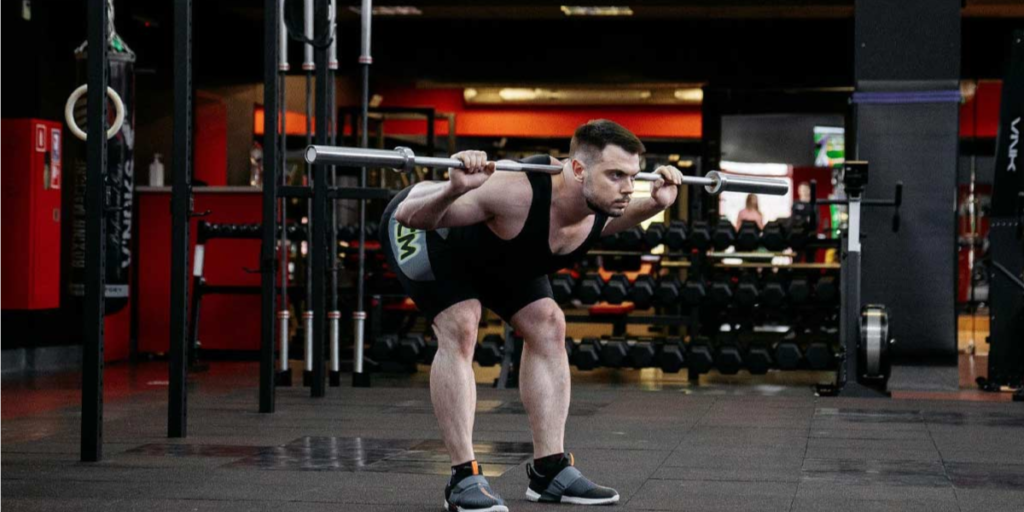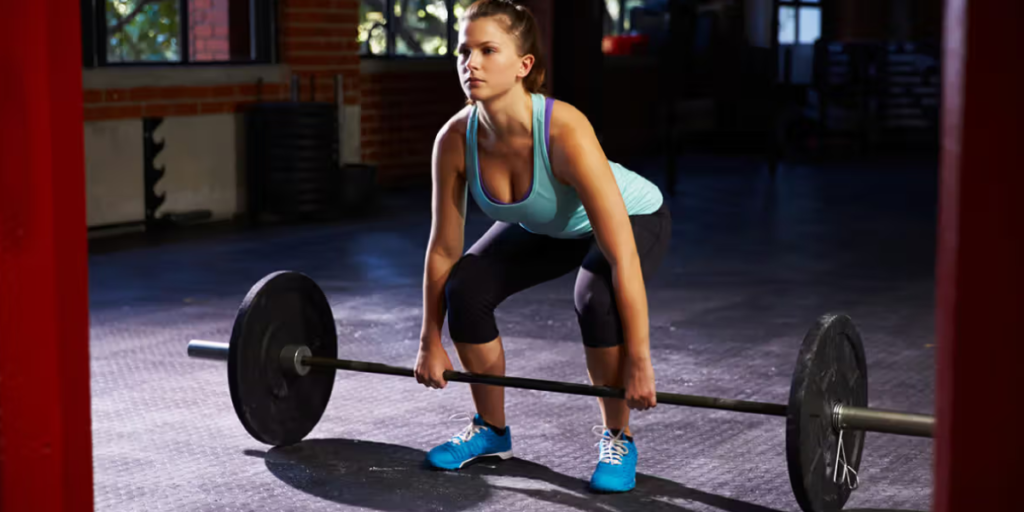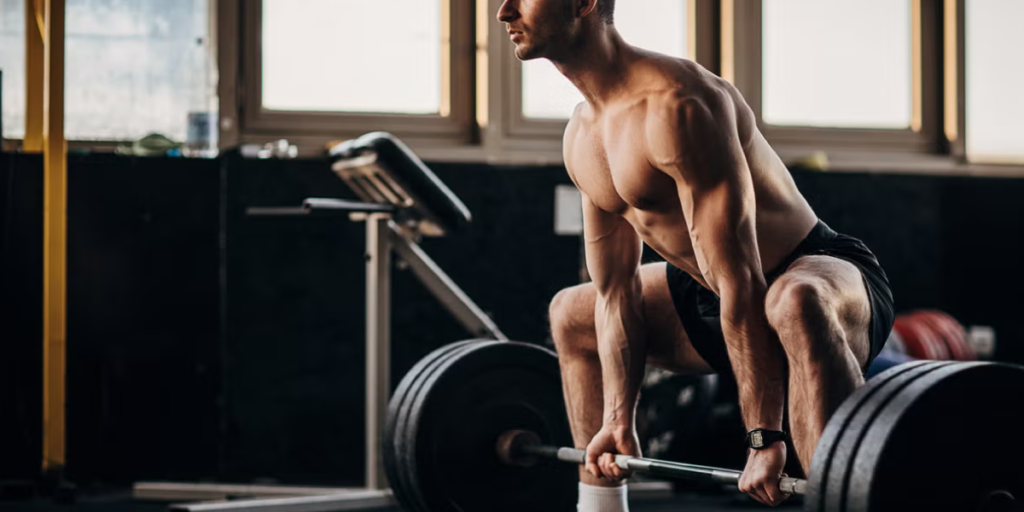Looking for a powerful and effective workout routine? Olympic lifting exercises can be a great choice. These exercises have proven to be a game-changer for fitness enthusiasts and athletes across the globe. From building strength and explosive power to improving overall athleticism, these movements offer a host of advantages that extend beyond the weightlifting platform.
In this blog, we’ll explore how incorporating Olympic lift exercises into your regimen can enhance muscle development, increase metabolism, and foster functional fitness. We’ll also provide practical tips for safely integrating these lifts into your routine.
Let’s begin without further adieu.
What are Olympic Lifting Exercises?

Olympic lifting exercises are a type of weightlifting that involves two main movements:
- the snatch
- and the clean and jerk.
They are a special kind of strength training, where you lift a barbell with heavy weights in a particular way. These exercises require a combination of strength, speed, and skill.
Let’s explore these two types of Olympic weightlifting exercises in a detailed manner.
The Snatch
The snatch is a dynamic and powerful movement in Olympic weightlifting. It involves lifting a barbell from the ground to overhead in one smooth motion. It requires explosive power and speed to execute the lift correctly.
This exercise primarily targets the hamstrings, quadriceps, glutes, lower back, shoulders, and upper back.
Here’s how it’s performed:
Starting Position
Stand with your feet shoulder-width apart and grip the barbell with your hands wider than your shoulders. Your back should be straight, and your chest up.
The First Pull
Push through your legs and lift the barbell off the ground while keeping it close to your body. Your back should stay flat during this phase.
The Second Pull
As the barbell reaches your hips, explode upward by extending your hips and knees. At the same time, pull the barbell upward with your arms, leading it close to your body.
The Catch
Drop quickly into a squat position and extend your arms overhead to catch the barbell. Stand up from the squat with the barbell overhead, fully locked out.
The Clean and Jerk
The clean and jerk is a two-part movement that showcases strength and technique in Olympic weightlifting. It involves lifting the barbell to your shoulders first and then pushing it overhead.
This exercise works similar muscle groups to the snatch, with a stronger emphasis on the upper body and shoulders during the jerk phase. Here’s how it’s done:
The Clean
- Starting Position: Stand with your feet shoulder-width apart and grip the barbell with your hands wider than your shoulders. Your back should be straight and your chest up.
- The First Pull: Lift the barbell off the ground using the power from your legs while keeping it close to your body.
- The Catch: As the barbell reaches your hips, quickly drop into a squat position and catch the barbell on your shoulders. Your elbows should be high to support the weight.
The Jerk
- Dip and Drive: From the front squat position, slightly dip your body and then drive upward explosively, extending your hips and knees.
- The Split: While the barbell is moving upward, split your legs forward and backward, creating a stable base to catch the barbell overhead.
- The Lockout: As you catch the barbell overhead, fully extend your arms and legs to complete the lift.
Benefits of Olympic Lifting Exercises

There are many benefits to learning and practicing Olympic lifting in your workout routine. Planning can be done in many ways depending on your specific goals. Here are some key benefits of learning to lift from a certified instructor:
Body Composition
Olympic lifting exercises like the snatch and clean and jerk engage multiple muscle groups in the body, such as legs, glutes, back, abs, shoulders, and arms. This comprehensive involvement helps burn more calories in less time compared to isolated exercises. Incorporating these lifts and complementary exercises can lead to —
- increased muscle mass,
- strength,
- and a reduction in body fat.
While Olympic lifting offers unique benefits, remember that diverse fitness perspectives exist. Check out the blog post on powerlifting-related myths for insights into misunderstood aspects of powerlifting and body composition, contributing to a well-rounded fitness perspective.
Muscular Power and Strength
Muscular power is how quickly you can move a weight. This kind of exercise emphasizes moving loads with maximum speed and power. By regularly performing these lifts, you can enhance your ability to generate explosive strength.
Improved muscular power not only helps in sports but also plays an important role in preventing falls, especially in older adults.
Coordination
These Olympic exercises demand precise coordination, rhythm, and timing. Learning and practicing these lifts enhance body awareness and coordination, which can be advantageous for daily chores. Moreover, engaging in new movements like weightlifting can also improve cognitive abilities in the long run.
Range of Motion
Contrary to the misconception that heavy lifting makes you stiff and bulky, Olympic weightlifting requires a full range of motion in the knees, hips, ankles, and shoulders. Consistently training through these ranges of motion can increase flexibility more effectively than static stretching, making you more agile and functional.
Work Capacity
This type of exercise can be programmed in different ways to enhance your overall fitness. By limiting rest time between sets and performing higher-intensity workouts, your work capacity increases. Over time, you’ll notice that you can recover faster from intense training, allowing you to do more in each workout.
Protect Against Injury
Olympic lifts are well-rounded exercises that prioritize flexibility and stability in crucial joints like the shoulders, hips, knees, and ankles. By controlling the movements throughout these joints’ full range of motion, these lifts lay a solid foundation for handling the demands of sports and daily activities. Embracing Olympic lifts in your training routine and improving mobility, strength, and stability can significantly reduce the risk of injuries.
Importantly, weightlifting itself is not harmful to the back. When performed correctly, These types of exercises use a safe approach, engaging the back and leg muscles while distributing the load to avoid straining the spine.
Additionally, strengthening the stabilizing muscles in the torso plays a vital role in reaping the benefits of Olympic lifting and promoting overall spinal health.
Increase In Bone Density
Getting stronger bones is crucial for preventing osteoporosis and fractures, particularly in women. Olympic lifts put a lot of pressure on the arms, legs, and spine, which stimulates the body to build new bones and increase bone density. This helps counteract the natural bone loss that occurs as we age.
In simple terms, this exercise can make our bones stronger and healthier, reducing the risk of bone-related problems as we get older.
Become Confident
Becoming confident is a wonderful result of getting stronger through weightlifting. When you build physical strength, it positively impacts every aspect of your life. You’ll feel more confident both inside and outside the weightlifting gym as you learn new skills and realize what your strong body can achieve. It’s thrilling to lift weights with the speed and skill of Olympic lifts, and many people find that mastering exercises like snatch and clean & jerk keeps them motivated to keep working out.
Don’t worry that weightlifting will make girls angry or aggressive. Being involved in sports of any kind encourages a competitive spirit, which is completely normal. Moreover, sports teach valuable skills, like focus and composure during tough times, which are helpful in everyday life. This is why many girls find joy and fulfillment in going to the gym and engaging in weightlifting activities.
Extremely Beneficial For Women
Weightlifting is extremely beneficial for women, and there are no biological reasons preventing them from lifting weights. In fact, women often train effectively because they are naturally more flexible than men. Weight training helps women build strength without making them bulky, as their hormones differ from male athletes.
Lifting weights does not increase the risk of infertility in women, nor does it affect their ability to give birth or have a regular menstrual cycle. These factors mostly depend on proper exercise planning, good nutrition, and sufficient rest.
Engaging in regular physical activity, including weightlifting, can lead to a more comfortable pregnancy and the birth of healthy children for women. It’s essential to know that this type of exercise is not harmful to women; instead, it offers a lot of health benefits and promotes overall well-being.
6 Best Olympic Movements to Add to Your Workout Routine

Here are the six best Olympic movements for your workout routine:
Power Clean
Suitable for all levels. Lift the barbell explosively from the floor to the shoulders, then lower it back down.
Front Squat
Suitable for all levels. Hold the barbell in front of your shoulders and squat down, then stand back up.
Squat Clean
Suitable for intermediate to advanced lifters. Similar to the power clean, but you catch the barbell in a full squat position.
Push Jerk
Suitable for intermediate to advanced lifters. Lift the barbell from your shoulders to overhead using an explosive push.
Power Snatch
Suitable for all levels. Lift the barbell from the floor to overhead in one explosive motion.
Squat Snatch
Suitable for intermediate to advanced lifters. Similar to the power snatch, but you catch the barbell in a full squat position.
Rules to Stay Safe

Staying safe during Olympic lifting is essential because it can be challenging and puts your body at risk of injuries. To protect yourself and enjoy the benefits, follow these simple rules:
Limit Training Frequency
Do Olympic lifts no more than three times a week to avoid overworking your muscles.
Build Strength Base
Before attempting Olympic lifts, develop a good strength foundation through regular weight training. Master exercises like deadlifts, squats, and military presses.
Strengthen Your Back
Strong back and shoulder muscles are vital for successful lifts. Include exercises like lat pulldowns, rows, and pull-ups to strengthen these areas.
Focus on Mobility and Flexibility
Olympic lifts require excellent mobility. Include foam rolling and stretching for your chest, hamstrings, calves, and glutes.
Use Resistance Bands
Incorporate resistance band exercises to improve hip and shoulder mobility for better Olympic lifting form.
Start Slow and Warm Up
Beginners should take their time and never skip warm-ups. Practice with a wooden dowel or PVC pipe to learn the proper technique.
Gradually Add Weight
Progress slowly by practicing with just the bar first. Gradually add weight, starting with 5-pound plates.
Do you want to learn Olympic lifting techniques? Come to Back Bay Fit’s Personal Training solution! Our coaches are experts in CrossFit and functional fitness competitions. We believe that mastering these technical lifts requires proper guidance, so our qualified coaches will design a personalized program just for you. It doesn’t matter if you’re a CrossFit fan, a student-athlete, or someone who enjoys weekend workouts – we’ve got the perfect plan to help you succeed. Join us and discover the art of Olympic lifting!
Wrapping Up
In conclusion, incorporating Olympic lifting exercises into your fitness routine can bring about a wide range of benefits that go beyond just physical strength. From improved body composition and increased muscle power to enhanced coordination and bone density, these lifts offer a holistic approach to fitness. While they may pose certain risks, adhering to safety guidelines and working with qualified coaches can mitigate any potential dangers.
FAQs
Which are the best accessory exercises for Olympic lifting?
Some effective accessory exercises include front squats, overhead squats, Romanian deadlifts, push presses, snatch grip deadlifts, and hang cleans. These exercises focus on core stability, leg strength, and upper body power.
Are Olympic powerlifting exercises suitable for beginners?
While the Olympic lifts can be challenging, beginners can learn and benefit from them with proper guidance and progression. It’s essential to start with lighter weights and focus on mastering the technique.
Is Olympic lifting good for bodybuilding?
Yes, Olympic lifting can be good for bodybuilding as it helps develop explosive power and overall strength and enhances muscle hypertrophy.
What are the 6 Olympic lifts?
The six types of Olympic lifts are:
- Power Clean (all levels)
- Front Squat (all levels)
- Squat Clean (Intermediate to Advanced)
- Push Jerk (Intermediate to Advanced)
- Power Snatch (All levels)
- Squat Snatch (Intermediate to Advanced)
The details of each lift are provided in the blog section.
What are shoulder flexibility exercises for Olympic lifting?
Shoulder flexibility exercises for Olympic lifting are specific movements that help make your shoulders more flexible. This improvement in flexibility ensures you can perform better during lifts and reduces the risk of injuries.
What are the main Olympic lifts?
The main Olympic lifts are the Snatch and the Clean and Jerk. Athletes lift a barbell from the floor to overhead, expressing their strength and technique in these explosive movements.
What are the three exercises of Olympic lifts?
Snatch, Clean and Jerk, and Power Clean are the three exercises of Olympic lifts.
Why are Olympic lifts so hard?
Olympic lifts are tough because they involve tricky movements that require perfect timing and coordination. You need a mix of strength, speed, and technique, but mastering them brings great satisfaction in weightlifting.





